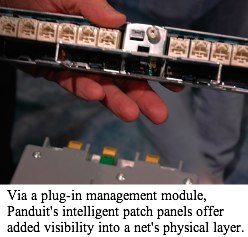I'm sure competing solutions exist (or maybe not -- you tell me). But this year's Interop marks the first time I've ever seen an intelligent patch panel: one that drives the visibility into your network another layer deeper than the visibility that might normally end with your routers and switches. The offering -- a <a href="http://www.bestofinterop.com/finalists/">Best of Interop finalist</a> -- comes from <a href="http://www.panduit.com">Panduit</a>, and about the only thing I can imagine comi

I'm sure competing solutions exist (or maybe not -- you tell me). But this year's Interop marks the first time I've ever seen an intelligent patch panel: one that drives the visibility into your network another layer deeper than the visibility that might normally end with your routers and switches. The offering -- a Best of Interop finalist -- comes from Panduit, and about the only thing I can imagine coming next might be intelligent RJ45 jacks. Actually, after I finished my video interview with Panduit's Mike Pula (below) and sarcastically mentioned that idea, he didn't laugh and said the idea actually solves a problem.
Where Panduit's PanView iQ really shines is in helping data center (or wiring closet) managers know for sure where the two endpoints of any given Cat 5/6 run are. Sure, when we set up our data centers, we have the best intentions in terms of diligently labeling all of our cables and ports so there's no mistake about where our cable runs begin and end. But despite our best intentions, we end up throwing a few ad hoc cables in, then a few more, and then the next thing you know, you have to walk a cable run to figure where the two endpoints of certain cables are. Even worse, you end up with a rat's nest of wiring (although I see way fewer of these today than in years gone by).
 As long as both ends of the cable are patched into separate PanView iQ intelligent patch panels, not only can you easily trace the connection by pushing buttons on one that cause LEDs on the other to illuminate (as shown in the video), through PanView's intelligence module, you also can pull the "paths" up into PanView's management console.
As long as both ends of the cable are patched into separate PanView iQ intelligent patch panels, not only can you easily trace the connection by pushing buttons on one that cause LEDs on the other to illuminate (as shown in the video), through PanView's intelligence module, you also can pull the "paths" up into PanView's management console.
Using the PanView software, you also can automatically or manually associate IP segments with specific cable runs. Each of Panduit's intelligent patch panels has one intelligent port that's capable of parsing MIBs from upstream device. From those MIBs, it extracts IP and MAC addresses, which then facilitates an automatic mapping of the logical and physical layers of your network. But, if you'd rather go into the management console and manually enter IP segment addresses to go with certain patch panels, you can do that, too.
Referring to the idea of intelligent RJ45 jacks, the reason that Pula actually thinks that could be a good idea is that not every RJ45 jack is going to be plugged into an intelligent patch panel. Let's say it's just dangling somewhere. Or, maybe it's plugged into a nonintelligent device. An intelligent RJ45 jack could provide some visibility into the situation that can't otherwise be had with nonintelligent RJ45 jacks. Hmmmm.
Finally, I'm guessing that there are other intelligent patch panels in the industry, some of which I'm sure are hiding in one of the many booths here at the show. Hula acknowledged that they might work together as well as when you have a single vendor's intelligent patch panel at both ends of a cable.
OK, so, standards anyone?
About the Author(s)
You May Also Like





